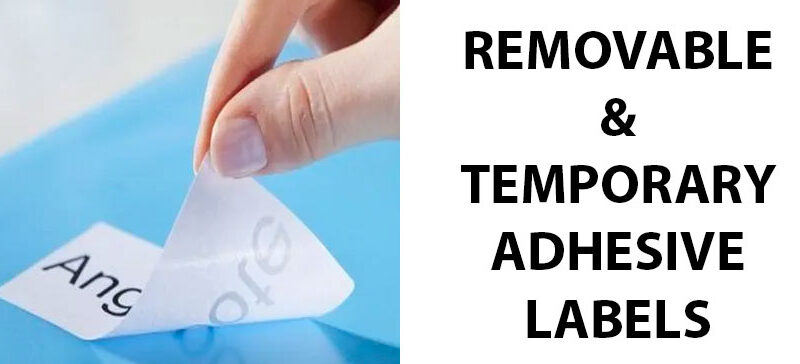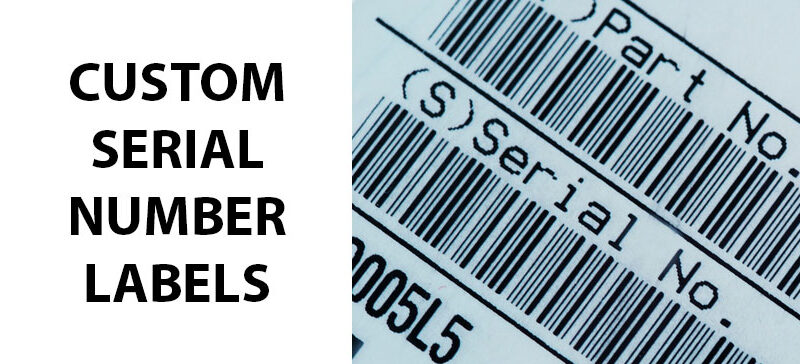Removable adhesive and temporary adhesive are two innovations that have changed the way we approach labeling applications. From retail displays to event promotions, these adhesives are incredibly versatile, allowing labels to be applied, adjusted, and removed with ease.
In this guide, we’ll explore the differences between removable adhesive and temporary adhesive, their unique properties, and their best uses. Whatever your industry–from medical to manufacturing and everything in between–removable and temporary adhesive can play a role in your label applications. But which one is best for you?
How Removable Adhesives Work
Removable adhesives are adhesives that can be applied, repositioned, and removed without leaving behind residue or damaging the surface. These adhesives adhere well while still being easy to peel off of many surface types. Removable wall adhesive is ideal for applications where labels might need to be adjusted or moved multiple times without damaging the wall or surface.
Removable adhesive works by striking a balance between adhesive strength and cohesion. Here’s how removable wall adhesive works:
- Initial tack: Removable adhesive has a moderate tack, meaning it has enough stickiness to adhere to surfaces. When the label is applied, the adhesive starts to bond with the surface due to its initial tackiness.
- Cohesion: Cohesion is the internal strength of the adhesive. In removable adhesives, cohesion is weaker compared to the adhesion to the surface. This allows the adhesive to remain cohesive enough to hold the label together but not so strong that it cannot be easily removed.
- Peelability: When it comes time to remove the label, the lower cohesion allows the adhesive to weaken and break away from itself, making it easy to peel the label off without leaving any residue.
- Surface interaction: Removable adhesives are designed to interact with surfaces in a way that does not create a strong bond. They do not chemically react with the surface or penetrate deeply into the material, making it easier to separate the adhesive from the surface.
Best Removable Adhesive Uses
Removable adhesive is versatile and flexible and can be used in a wide range of applications. Some of the best uses of removable adhesive include:
- Retail: Removable adhesive is perfect for attaching promotional labels, price tags, and product information to retail displays. Pricing and promotions can be updated without damaging products or displays.
- Temporary signage: For short-term events or exhibitions, removable wall adhesive can be used to display temporary signage without damaging the wall or surface.
- Healthcare: In healthcare, removable adhesive can be used in many ways. For example, in the lab, specimen containers need to be labeled for accurate testing. Once finished, the label can be removed and the container sanitized for reuse.
- Shipping: Permanent labels are fine for cardboard boxes and other single-use containers, but for reusable shipping containers, removable adhesive is the way to go. With removable adhesive, you can update the shipping information over and over without damaging your container.
- Removable wall adhesive: Use removable wall adhesive to hang pictures, promotional posters, or safety posters in your business. When removed, the adhesive won’t damage the wall.
When Not to Use Removable Adhesives
Although removable adhesive has a number of benefits, it won’t always be the right fit for your application. Here are some instances when you might want to avoid removable adhesive:
- Cost: Removable adhesive is generally more expensive than permanent adhesive. If you’re looking to save money and you don’t need removability, a permanent adhesive may be the better option.
- Extreme environment: Removable adhesives are often more sensitive to environmental factors. If your labels will be used in extreme conditions, you may want to opt for a more durable adhesive.
How Temporary Adhesives Work
Temporary adhesives are similar to removable adhesives. They are formulated to provide a reliable bond for a specific period, after which they are intended to be removed. These adhesives are ideal for short-term applications, like event badges, promotional stickers, or temporary signage. Some examples of temporary adhesives include wood glue, silicone sealants, and pressure sensitive tapes.
Here’s a little more about how temporary adhesives works:
- Initial tack: Temporary adhesives have enough initial tack to quickly bond when applied to the surface.
- Cohesion: Like removable adhesives, temporary adhesives have weak cohesion, meaning the internal strength of the adhesive is low. This allows the adhesive to be removed without causing damage.
- Time-bound properties: Temporary adhesive is formulated to maintain its adhesive properties for a specific period. Once the time has elapsed, the adhesive’s properties begin to weaken, making it easier to remove.
- Removal: While removable adhesives can often be peeled away with force, some temporary adhesives require an extra step. For example, hot-melt and solvent-based adhesives are removed with a solvent or heat, while water-based adhesives can be dissolved with warm, soapy water.
Best Uses for Temporary Adhesives
Temporary adhesives can be used in a variety of industries. Here are some of the best uses for temporary adhesives:
- Event badges: Temporary adhesives are perfect for event badges and name tags attached to clothing. They provide a reliable hold during the event and can be easily removed at the end.
- Promotional stickers: Temporary adhesives are commonly used for promotional stickers that are applied to products or packaging during a sales event or promotion.
- Displays: Temporary adhesive is often used for wall and window decals for displays or seasonal decoration.
- Positioning aid: During manufacturing, temporary adhesives can be used to position components during assembly. Once fully assembled, the adhesive can be removed.
When Not to Use Temporary Adhesives
While temporary adhesives work great for short-term bonding, there are certain situations where they may not be the best choice. Depending on the type of adhesive used for your labeling needs, you’ll want to avoid extreme heat, cold, or exposure to water.
Here are some other instances where you might want to avoid temporary adhesive:
- Heavy objects: Temporary adhesives are designed for lightweight applications and should not be used to bond heavy objects.
- Long-term use: Temporary adhesive is meant to be a temporary bonding solution. If you need a long-term application, you should look for a permanent adhesive.
- Outdoor use: While some temporary adhesives can handle short-term outdoor use, prolonged exposure to the elements will weaken their adhesive properties.
- High vibration or movement: Because of the way temporary adhesives work, they may not hold up well in environments with high vibration or frequent movement.
If you’re looking for temporary or removable adhesive labels, Coast Label has you covered. We work with you one-on-one and will help you determine the right adhesive for your unique labeling needs. Contact Coast Label today to get started!



